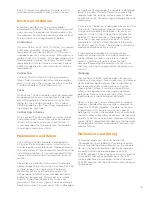
4
for the existing system voltage. If exposed
to sunlight, the electrical material must be
UVresistant.
• String configuration should be planned in
accordance with inverter manufacturer’s
instructions.
• If the installation is taking place in Canada, it
must be in accordance with CSA C22.1, Safety
Standard for Electrical Installations, Canadian
Electrical Code, Part1.
Fire Safety
• The presence of photovoltaic modules and
support structures (racking systems) on a
roof can change the roofing system’s fire
performance.
• Roof construction and photovoltaic system
support structures may affect the fire safety
of a building. Improper installation may
create a hazard in the event of a fire.
• The module is certified by CSA for use over a
Class ATPO, EPDM and PVC roofing systems
when installed per these instructions. They
are not certified for other applications.
• The Sunflare wire tray is required to maintain
the fire rating of the modules.
• Only Butyl based adhesives are certified
to adhere the Flex60 modules to a roof
membrane.
• Use components such as ground fault circuit
breakers and fuses as required by local
authorities.
• Provide rapid shutdown devices per the NEC.
• The fire rating of this module is valid only
when mounted in the manner specified in
the mechanical mounting instructions in this
manual.
• Consult your local authority for guidelines
and requirements for building and or
structural fire safety.
• Do not install this module near flammable
materials or materials with flammable
off gasses.
Installation Safety
• Follow all local and national safety
precautions when on a roof, including but not
limited to fall protection, gloves, helmets, and
safety glasses.
• Warning!
A photovoltaic panel can act as a
sail in even low wind conditions knocking
or pulling an installer off a roof. In addition,
panels can become missiles if unsecured and
blown away by the wind. A flying module
can injure roofers or people on the ground.
Use all appropriate precautions including fall
protection and module capture devices to
ensure safe handling in the event of winds
or wind gusts. Note, wind gusts can be
unpredictable and are not always preceded by
increased wind speeds. Care must be taken to
ensure panels are always safely secured.
• When handling electrical components use
all appropriately rated personal protective
equipment for handling any possible voltages
at the job site.
• Warning!
Do not install solar systems when it
is raining or the work surfaces are wet, icy, or
otherwise slippery. This could lean to personal
injury.
• Warning!
Do not install in the rain, snow or in
windy conditions. This could lean to personal
injury.
• Avoid exposing cables to direct sunlight to
help prevent their degradation over time.
• Danger!
Never open electrical connections
(such as connectors) when the circuit is under
load.
• Danger!
Contact with electrically charged
parts of the panels, such as terminals, can
result in burns, sparks and lethal shock
whether or not the panel is connected.
• Keep unqualified persons away from the work
area and the system during transportation
and installation.
• Completely cover the module with an opaque
material during installation to prevent
electricity from being generated.
• Do not wear metallic jewelry including ear,
nose, and lip rings, watchbands, pins, or any
other metallic object during installation or
troubleshooting of photovoltaic systems.
• Use only insulated tools that are approved
for working on electrical installation at the
voltages possible present at the job site.
• Follow all safety regulations and instructions
in the installation manuals for all components
of the system.

































